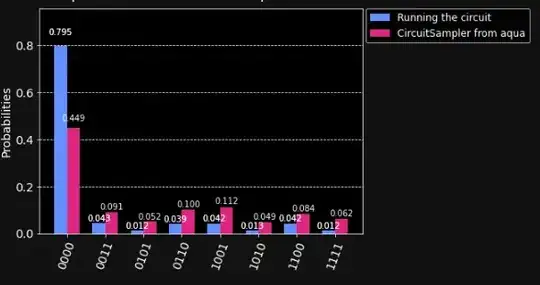I am trying to wrap my head around Qiskit Aqua Operators and I stumbled upon this:
My code
t=0.5
hamiltonian=get_hamiltonian(1,1) #a four 4 qubit hamiltonian (Transverse field Ising model)
evo_time=Parameter("t")
evo_op=(evo_time*hamiltonian).exp_i()
evo_op1 = evo_op @ (Zero^4)
trotter_op=PauliTrotterEvolution(trotter_mode=Suzuki(reps=10,order=1)).convert(evo_op1)
trotter_op_values=trotter_op.bind_parameters({evo_time: t})
circuit1=trotter_op_values.to_circuit()
backend=Aer.get_backend("qasm_simulator")
circuit1.measure_all()
counts1=execute(circuit1, backend=backend, shots=10024).result().get_counts()
for key in counts1.keys():
counts1[key]=counts1[key]/10024
a=0
I had to instantiate again the trotter_op because trotter_op_values.to_circuit()
#didn't create a new circuit and instead, by having done circuit1.measure_all()
trotter_op was modified as well.
trotter_op=PauliTrotterEvolution(trotter_mode=Suzuki(reps=10,order=1)).convert(evo_op1)
trotter_op_values=trotter_op.bind_parameters({evo_time: t})
sampler=CircuitSampler(backend=Aer.get_backend("qasm_simulator"))
sampler.quantum_instance.shots=10024
results1=sampler.convert(trotter_op_values).primitive
#normalize the results from the circuitsampler
for key in results1.keys():
a+=results1[key]
for key in results1.keys():
results1[key]=results1[key]/a
assert counts1.keys()==results1.keys()
assert sum(counts1.values()) #check normalization
assert sum(results1.values()) #check normalization
for key in results1.keys():
print("state: {} | Counts1: {} | Results1: {}".format(key,counts1[key], results1[key]))
plot_histogram([counts1, results1], legend=["Running the circuit","CircuitSampler from aqua"])
What I expected
Since the evo_op1 is just a CircuitStateFn whose initialization was the zero state for the 4 qubits then, passing this into CircuitSampler the CircuitStateFn would be replaced by a DictStateFn whose amplitudes would be the same as measuring all 4 qubits in the trotterization circuit with a zero state initialization (my circuit1).
What I got
The histograms never match, for any value of t except t=0. However, there is always a clear similarity between the plots (for small t the probability for 0000 is always the biggest for example and all other states have similiar probabilities, but never exactly equal)
What am I missing? Was it a bad interpretation of the Operator Flow?
